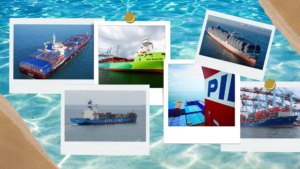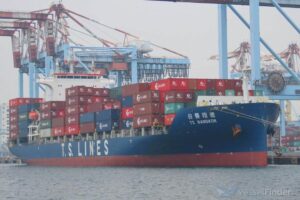Global container rankings: The Mid-Tier carriers climbing quietly

![]()
The global shipping industry is often dominated by headlines about mega-carriers. But beneath the Top 10 lies a group of fast-moving, strategically agile Mid-Tier carriers that are steadily gaining ground. These operators may not yet rival the capacity of MSC, Maersk, Cosco, and the other giants, but their growth strategies, operational models, and expanding fleets are reshaping the dynamics of container shipping.
In this article, we take a closer look at Mid-Tier carriers ranked 11–20 based on Alphaliner’s list, in the global container rankings quietly climbing the industry ladder.
Wan Hai Lines: Quiet Strength with Heavy Ownership
Taiwan-based Wan Hai Lines operates a fleet of 113 ships with a striking 112 owned vessels, representing a highly asset-heavy model. With 537,489 TEU in total capacity and an orderbook of 33 ships, Wan Hai is pursuing strong organic growth. Despite its low chartered ratio, its expansion plan signals confidence in long-term market presence. It exemplifies a Mid-Tier carrier with firm roots and forward motion.

PIL: Rebuilding with Balanced Strategy
Pacific International Lines (PIL), headquartered in Singapore, is on a strategic comeback. With 423,720 TEU across 97 vessels, PIL holds a fleet that’s 79% owned. Its 21 ships on order suggest renewed confidence after financial restructuring. PIL reflects the kind of mid-tier operator adapting for a more stable and competitive future.
Sea Lead Shipping: Scale Without Ownership
One of the most remarkable Mid-Tier carriers, Sea Lead Shipping, runs 50 vessels with only 2 owned. It holds 201,439 TEU, all virtually on charter. Despite its low asset exposure, Sea Lead had zero ships on order at the time of data, indicating a highly flexible, demand-driven approach. Its model proves that a carrier can gain rank without owning the steel.
X-Press Feeders: From Feeder to Force
With 106 ships and 188,540 TEU, X-Press Feeders has evolved far beyond a regional player. The company owns 47 ships and charters 59, with 11 ships on order, reflecting long-term regional service growth. As a key feeder operator, especially in Asia and the Middle East, it’s cementing its role as a critical link in global supply chains.
SITC: Conservative Growth, Strong Ownership
Chinese carrier SITC operates 121 ships and holds 187,835 TEU in total capacity. With 103 owned vessels, SITC takes a conservative, control-focused approach. Its 10 ships on order suggest steady, calculated expansion, reinforcing its position as a reliable Mid-Tier carrier with strong regional dominance.
Unifeeder: Asset-Light and Scaling Fast
Part of the DP World group, Unifeeder exemplifies the asset-light model with 94 chartered vessels and zero owned ships. It controls 154,182 TEU and has 14 ships on order, making it one of the most agile players among mid-tier ranks. Focused on short-sea and feeder operations in Europe and beyond, Unifeeder continues to expand its footprint without increasing ownership risk.
IRISL Group: Regional Power, Global Constraints
Iran’s IRISL Group maintains a fleet of 32 owned ships with a total capacity of 144,470 TEU. Although it has no ships on order, IRISL’s operational role in the Persian Gulf and nearby regions remains significant. Sanctions and global limitations may hold it back, but its existing fleet places it firmly among the Mid-Tier carriers in terms of scale.
KMTC: Steady Expansion from Korea
Korea Marine Transport Co. (KMTC) manages 63 ships, split between 30 owned and 33 chartered, totaling 143,569 TEU. With 4 ships on order, KMTC continues to grow steadily, leveraging its strong position in the intra-Asia trade. It reflects a well-balanced model among mid-tier container carriers.
Sinokor Merchant Marine: Larger Than It Looks
Despite its lower TEU total (140,435 TEU), Sinokor operates a large fleet of 74 vessels, 71 of which are owned. Its reliance on its own tonnage, alongside 4 ships on order, shows a commitment to long-term control and regional expansion, particularly in East Asia and Russian Far East routes.
TS Lines: Small But Aggressive
With 40 vessels and 106,252 TEU, Taiwan’s TS Lines maintains a relatively small footprint, but its growth plan is bold. With 7 ships on order, and 35 vessels owned, TS Lines is building strength through investment and efficiency. Among Mid-Tier carriers, it’s one of the most assertive in fleet development.

The Mid-Tier carries are climbing, quietly but steadily
The global container rankings are more than a list of mega-carriers. They also tell the story of Mid-Tier carriers, regional champions, smart operators, and strategic risers. Whether growing through chartered flexibility like Sea Lead and Unifeeder, or via ownership-driven models like Wan Hai and TS Lines, these players are reshaping global trade from the middle of the board.
In an unpredictable market, it’s often the Mid-Tier carriers, not just the giants, who move the fastest and adapt the smartest.
![]()
The post Global container rankings: The Mid-Tier carriers climbing quietly appeared first on Container News.
Content Original Link:
" target="_blank">

































































